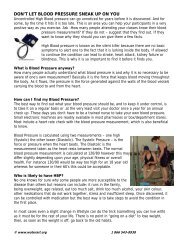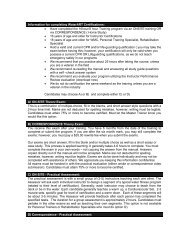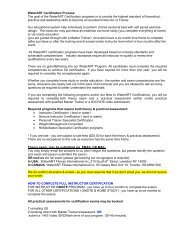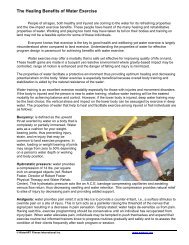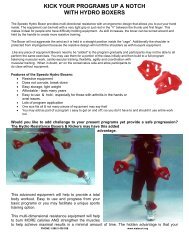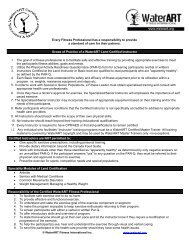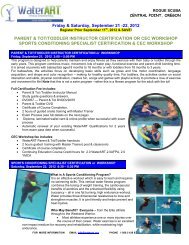ParMed-X for Pregnancy - WaterART Fitness International
ParMed-X for Pregnancy - WaterART Fitness International
ParMed-X for Pregnancy - WaterART Fitness International
Create successful ePaper yourself
Turn your PDF publications into a flip-book with our unique Google optimized e-Paper software.
Physical Activity Readiness<br />
Medical Examination <strong>for</strong><br />
<strong>Pregnancy</strong> (2002)<br />
PARmed-X <strong>for</strong> PREGNANCY<br />
PARmed-X <strong>for</strong> PREGNANCY is a guideline <strong>for</strong> health screening<br />
prior to participation in a prenatal fitness class or other exercise.<br />
Healthy women with uncomplicated pregnancies can integrate physical activity into their daily living and can participate without significant risks either to themselves<br />
or to their unborn child. Postulated benefits of such programs include improved aerobic and muscular fitness, promotion of appropriate weight gain, and facilitation<br />
of labour. Regular exercise may also help to prevent gestational glucose intolerance and pregnancy-induced hypertension.<br />
The safety of prenatal exercise programs depends on an adequate level of maternal-fetal physiological reserve. PARmed-X <strong>for</strong> PREGNANCY is a convenient<br />
checklist and prescription <strong>for</strong> use by health care providers to evaluate pregnant patients who want to enter a prenatal fitness program and <strong>for</strong> ongoing medical<br />
surveillance of exercising pregnant patients.<br />
Instructions <strong>for</strong> use of the 4-page PARmed-X <strong>for</strong> PREGNANCY are the following:<br />
1. The patient should fill out the section on PATIENT INFORMATION and the PRE-EXERCISE HEALTH CHECKLIST (PART 1, 2, 3, and 4 on p. 1) and give<br />
the <strong>for</strong>m to the health care provider monitoring her pregnancy.<br />
2. The health care provider should check the in<strong>for</strong>mation provided by the patient <strong>for</strong> accuracy and fill out SECTION C on CONTRAINDICATIONS (p. 2) based<br />
on current medical in<strong>for</strong>mation.<br />
3. If no exercise contraindications exist, the HEALTH EVALUATION FORM (p. 3) should be completed, signed by the health care provider, and given by the<br />
patient to her prenatal fitness professional.<br />
In addition to prudent medical care, participation in appropriate types, intensities and amounts of exercise is recommended to increase the likelihood of a beneficial<br />
pregnancy outcome. PARmed-X <strong>for</strong> PREGNANCY provides recommendations <strong>for</strong> individualized exercise prescription (p. 3) and program safety (p. 4).<br />
NOTE: Sections A and B should be completed by the patient be<strong>for</strong>e the appointment with the health care provider.<br />
A<br />
PATIENT INFORMATION<br />
NAME ____________________________________________________________________________________________________________________________________<br />
ADDRESS _________________________________________________________________________________________________________________________________<br />
TELEPHONE _____________________________ BIRTHDATE ____________________ HEALTH INSURANCE No. __________________________________________<br />
NAME OF<br />
PRENATAL FITNESS<br />
PRENATAL FITNESS PROFESSIONAL ________________________________________ PROFESSIONAL’S PHONE NUMBER ________________________________<br />
B<br />
PRE-EXERCISE HEALTH CHECKLIST<br />
PART 1: GENERAL HEALTH STATUS<br />
In the past, have you experienced (check YES or NO):<br />
YES NO<br />
1. Miscarriage in an earlier pregnacy ❏ ❏<br />
2. Other pregnancy complications ❏ ❏<br />
3. I have completed a PAR-Q within the last 30 days. ❏ ❏<br />
If you answered YES to question 1 or 2, please explain:<br />
________________________________________________________<br />
Number of previous pregnancies _______<br />
PART 2: STATUS OF CURRENT PREGNANCY<br />
Due Date: ________________________________________________<br />
During this pregnancy, have you experienced:<br />
YES NO<br />
1. Marked fatigue ❏ ❏<br />
2. Bleeding from the vagina (“spotting”) ❏ ❏<br />
3. Unexplained faintness or dizziness ❏ ❏<br />
4. Unexplained abdominal pain ❏ ❏<br />
5. Sudden swelling of ankles, hands or face ❏ ❏<br />
6. Persistent headaches or problems with headaches ❏ ❏<br />
7. Swelling, pain or redness in the calf of one leg ❏ ❏<br />
8. Absence of fetal movement after 6 th month ❏ ❏<br />
9. Failure to gain weight after 5 th month ❏ ❏<br />
If you answered YES to any of the above questions, please explain:<br />
________________________________________________________<br />
PHYSICAL ACTIVITY READINESS<br />
MEDICAL EXAMINATION<br />
PART 3: ACTIVITY HABITS DURING THE PAST MONTH<br />
1. List only regular fitness/recreational activities:<br />
____________________________________________________<br />
____________________________________________________<br />
INTENSITY FREQUENCY TIME<br />
(times/week)<br />
(minutes/day)<br />
1-2 2-4 4 + once/hr) ❏ ❏<br />
Prolonged standing ❏ ❏<br />
Mainly sitting ❏ ❏<br />
Normal daily activity ❏ ❏<br />
3. Do you currently smoke tobacco* ❏ ❏<br />
4. Do you consume alcohol* ❏ ❏<br />
PART 4: PHYSICAL ACTIVITY INTENTIONS<br />
What physical activity do you intend to do<br />
________________________________________________________<br />
Is this a change from what you currently do ❏ YES ❏ NO<br />
*NOTE: PREGNANT WOMEN ARE STRONGLY ADVISED NOT TO SMOKE<br />
OR CONSUME ALCOHOL DURING PREGNANCY AND DURING LACTATION.<br />
© Canadian Society <strong>for</strong> Exercise Physiology<br />
Société canadienne de physiologie de l'exercice<br />
Supported by:<br />
Health<br />
Canada<br />
Santé<br />
Canada<br />
1
Physical Activity Readiness<br />
Medical Examination <strong>for</strong><br />
<strong>Pregnancy</strong> (2002)<br />
PARmed-X <strong>for</strong> PREGNANCY<br />
C<br />
CONTRAINDICATIONS TO EXERCISE: to be completed by your health care provider<br />
Absolute Contraindications<br />
Does the patient have:<br />
YES NO<br />
1. Ruptured membranes, premature labour ❏ ❏<br />
2. Persistent second or third trimester<br />
bleeding/placenta previa ❏ ❏<br />
3. <strong>Pregnancy</strong>-induced hypertension or pre-eclampsia ❏ ❏<br />
4. Incompetent cervix ❏ ❏<br />
5. Evidence of intrauterine growth restriction ❏ ❏<br />
6. High-order pregnancy (e.g., triplets) ❏ ❏<br />
7. Uncontrolled Type I diabetes, hypertension or<br />
thyroid disease, other serious cardiovascular,<br />
respiratory or systemic disorder ❏ ❏<br />
PHYSICAL ACTIVITY READINESS<br />
MEDICAL EXAMINATION<br />
Relative Contraindications<br />
Does the patient have:<br />
YES NO<br />
1. History of spontaneous abortion or premature labour<br />
in previous pregnancies ❏ ❏<br />
2. Mild/moderate cardiovascular or respiratory disease<br />
(e.g., chronic hypertension, asthma) ❏ ❏<br />
3. Anemia or iron deficiency (Hb < 100 g/L) ❏ ❏<br />
4. Malnutrition or eating disorder (anorexia, bulimia) ❏ ❏<br />
5. Twin pregnancy after 28th week ❏ ❏<br />
6. Other significant medical condition ❏ ❏<br />
Please specify: ___________________________________________<br />
NOTE: Risk may exceed benefits of regular physical activity. The decision to<br />
be physically active or not should be made with qualified medical advice.<br />
PHYSICAL ACTIVITY RECOMMENDATION: ❏ Recommended/Approved ❏ Contraindicated<br />
RATE OF PROGRESSION: The best time to progress is during the second<br />
trimester since risks and discom<strong>for</strong>ts of pregnancy are lowest at that time.<br />
Aerobic exercise should be increased gradually during the second trimester from<br />
a minimum of 15 minutes per session, 3 times per week (at the appropriate target<br />
heart rate or RPE to a maximum of approximately 30 minutes per session, 4 times<br />
per week (at the appropriate target heart rate or RPE).<br />
WARM-UP/COOL-DOWN: Aerobic activity should be preceded by a brief (10-<br />
15 min.) warm-up and followed by a short (10-15 min.) cool-down. Low intensity<br />
calesthenics, stretching and relaxation exercises should be included in the warmup/cool-down.<br />
F<br />
FREQUENCY<br />
Begin at 3 times<br />
per week and<br />
progress to<br />
four times<br />
per week<br />
I<br />
INTENSITY<br />
Exercise within<br />
an appropriate<br />
RPE range<br />
and/or target<br />
heart rate<br />
zone<br />
Prescription <strong>for</strong> Aerobic Activity<br />
T<br />
TIME<br />
Attempt 15<br />
minutes, even<br />
if it means<br />
reducing the<br />
intensity.<br />
Rest intervals<br />
may be helpful<br />
T<br />
TYPE<br />
Non weight-bearing<br />
or low-impact endurance<br />
exercise using large<br />
muscle groups (e.g.,<br />
walking, stationary<br />
cycling, swimming,<br />
aquatic exercises, low<br />
impact aerobics)<br />
“TALK TEST” - A final check to avoid overexertion is to use the “talk test”. The exercise intensity is excessive<br />
if you cannot carry on a verbal conversation while exercising.<br />
PRESCRIPTION/MONITORING OF INTENSITY: The best way to prescribe<br />
and monitor exercise is by combining the heart rate and rating of perceived<br />
exertion (RPE) methods.<br />
TARGET HEART<br />
RATE ZONES<br />
The heart rate zones<br />
shown below are<br />
appropriate <strong>for</strong> most<br />
pregnant women. Work<br />
during the lower end of<br />
the HR range at the start<br />
of a new exercise<br />
program and in late<br />
pregnancy.<br />
Heart Rate<br />
Age Range<br />
< 20 140-155<br />
20-29 135-150<br />
30-39 130-145<br />
≥ 40 125-140<br />
RATING OF PERCEIVED<br />
EXERTION (RPE)<br />
Check the accuracy of your heart rate target zone<br />
by comparing it to the scale below. A range of<br />
about 12-14 (somewhat hard) is appropriate <strong>for</strong><br />
most pregnant women.<br />
6<br />
7 Very, very light<br />
8<br />
9 Somewhat light<br />
10<br />
11 Fairly light<br />
12<br />
13 Somewhat hard<br />
14<br />
15 Hard<br />
16<br />
17 Very hard<br />
18<br />
19 Very, very hard<br />
20<br />
The original PARmed-X <strong>for</strong> PREGNANCY was developed by L.A. Wolfe, Ph.D., Queen’s University. The muscular conditioning component was developed by M.F.<br />
Mottola, Ph.D., University of Western Ontario. The document has been revised based on advice from an Expert Advisory Committee of the Canadian Society <strong>for</strong><br />
Exercise Physiology chaired by Dr. N. Gledhill, with additonal input from Drs. Wolfe and Mottola, and Gregory A.L. Davies, M.D.,FRCS(C) Department of Obstetrics<br />
and Gynaecology, Queen’s University, 2002.<br />
No changes permitted. Translation and reproduction in its entirety is encouraged.<br />
Disponible en français sous le titre «Examination medicale sur l’aptitude à l’activité physique pour les femmes enceintes (X-AAP pour les femmes enceintes)»<br />
To order additional printed copies of the PARmed-X <strong>for</strong> PREGNANCY, the PARmed-X and/or the PAR-Q, (<strong>for</strong> a nominal charge) contact the:<br />
Canadian Society <strong>for</strong> Exercise Physiology<br />
185 Somerset St. West, Suite 202, Ottawa, Ontario CANADA K2P 0J2<br />
tel.: 1-877-651-3755 FAX (613) 234-3565 www.csep.ca<br />
2
○ ○ ○ ○ ○ ○ ○ ○ ○ ○ ○ ○ ○ ○ ○ ○ ○ ○ ○ ○ ○ ○ ○ ○ ○ ○ ○ ○ ○ ○ ○ ○ ○ ○ ○ ○ ○ ○ ○ ○ ○ ○ ○ ○ ○ ○ ○ ○ ○ ○ ○ ○ ○ ○ ○ ○ ○ ○ ○ ○ ○ ○ ○ ○ ○ ○ ○ ○ ○ ○ ○ ○ ○ ○ ○ ○<br />
Physical Activity Readiness<br />
Medical Examination <strong>for</strong><br />
<strong>Pregnancy</strong> (2002)<br />
PARmed-X <strong>for</strong> PREGNANCY<br />
PHYSICAL ACTIVITY READINESS<br />
MEDICAL EXAMINATION<br />
Prescription <strong>for</strong> Muscular Conditioning<br />
It is important to condition all<br />
major muscle groups during<br />
both prenatal and postnatal<br />
periods.<br />
WARM-UPS & COOL DOWN:<br />
Range of Motion: neck,<br />
shoulder girdle, back, arms,<br />
hips, knees, ankles, etc.<br />
Static Stretching: all major<br />
muscle groups<br />
(DO NOT OVER STRETCH!)<br />
EXAMPLES OF MUSCULAR STRENGTHENING EXERCISES<br />
CATEGORY PURPOSE EXAMPLE<br />
Upper back Promotion of good posture Shoulder shrugs, shoulder blade pinch<br />
Lower back Promotion of good posture Modified standing opposite leg & arm lifts<br />
Abdomen Promotion of good posture, Abdominal tightening, abdominal<br />
prevent low-back pain, prevent<br />
curl-ups, head raises lying on side or standing position<br />
diastasis recti, strengthen muscles<br />
of labour<br />
Pelvic floor Promotion of good bladder control, “Wave”, “elevator”<br />
(“Kegels”) prevention of urinary incontinence<br />
Upper body Improve muscular support <strong>for</strong> breasts Shoulder rotations, modified push-ups against a wall<br />
Buttocks, Facilitation of weight-bearing, prevention Buttocks squeeze,standing leg lifts, heel raises<br />
lower limbs of varicose veins<br />
✁<br />
VARIABLE<br />
Body Position<br />
Joint Laxity<br />
Abdominal Muscles<br />
Posture<br />
Precautions<br />
<strong>for</strong><br />
Resistance Exercise<br />
PRECAUTIONS FOR MUSCULAR CONDITIONING DURING PREGNANCY<br />
EFFECTS OF PREGNANCY<br />
• in the supine position (lying on the back), the enlarged uterus<br />
may either decrease the flow of blood returning from the lower<br />
half of the body as it presses on a major vein (inferior vena cava)<br />
or it may decrease flow to a major artery (abdominal aorta)<br />
• ligaments become relaxed due to increasing hormone levels<br />
• joints may be prone to injury<br />
• presence of a rippling (bulging) of connective tissue along the<br />
midline of the pregnant abdomen (diastasis recti) may be seen<br />
during abdominal exercise<br />
• increasing weight of enlarged breasts and uterus may cause a<br />
<strong>for</strong>ward shift in the centre of gravity and may increase the arch in<br />
the lower back<br />
• this may also cause shoulders to slump <strong>for</strong>ward<br />
EXERCISE MODIFICATIONS<br />
• past 4 months of gestation, exercises normally done in the<br />
supine position should be altered<br />
• such exercises should be done side lying or standing<br />
• avoid rapid changes in direction and bouncing during exercises<br />
• stretching should be per<strong>for</strong>med with controlled movements<br />
• abdominal exercises are not recommended if diastasis recti<br />
develops<br />
• emphasis on correct posture and neutral pelvic alignment.<br />
Neutral pelvic alignment is found by bending the knees, feet<br />
shoulder width apart, and aligning the pelvis between<br />
accentuated lordosis and the posterior pelvic tilt position.<br />
• emphasis must be placed on continuous breathing throughout exercise<br />
• exhale on exertion, inhale on relaxation using high repetitions and low weights<br />
• Valsalva Manoevre (holding breath while working against a resistance) causes a change in blood pressure and there<strong>for</strong>e<br />
should be avoided<br />
• avoid exercise in supine position past 4 months gestation<br />
PARmed-X <strong>for</strong> <strong>Pregnancy</strong> - Health Evaluation Form<br />
(to be completed by patient and given to the prenatal fitness professional<br />
after obtaining medical clearance to exercise)<br />
I, _____________________________________ PLEASE PRINT (patient’s name), have discussed my plans to participate in physical<br />
activity during my current pregnancy with my health care provider and I have obtained his/her approval to begin participation.<br />
Signed: ___________________________________________<br />
(patient’s signature)<br />
Date: __________________________________________<br />
HEALTH CARE PROVIDER’S COMMENTS:<br />
Name of health care provider: _________________________________<br />
Address: _________________________________________________<br />
________________________________________________________<br />
Telephone: _______________________________________________<br />
_______________________________________________________<br />
_______________________________________________________<br />
_______________________________________________________<br />
___________________________________________________ M.D.<br />
(health care provider’s signature)<br />
3
○ ○ ○ ○ ○ ○ ○ ○ ○ ○ ○ ○ ○ ○ ○ ○ ○ ○ ○ ○ ○ ○ ○ ○ ○ ○ ○ ○ ○ ○ ○ ○ ○ ○ ○ ○ ○ ○ ○ ○ ○ ○ ○ ○ ○ ○ ○ ○ ○ ○ ○ ○ ○ ○ ○ ○ ○ ○ ○ ○ ○ ○ ○ ○ ○ ○ ○ ○ ○ ○ ○ ○ ○ ○ ○ ○<br />
Physical Activity Readiness<br />
Medical Examination <strong>for</strong><br />
<strong>Pregnancy</strong> (2002)<br />
Advice <strong>for</strong> Active Living During <strong>Pregnancy</strong><br />
<strong>Pregnancy</strong> is a time when women can make beneficial changes in their health habits to protect and promote the healthy development of<br />
their unborn babies. These changes include adopting improved eating habits, abstinence from smoking and alcohol intake, and<br />
participating in regular moderate physical activity. Since all of these changes can be carried over into the postnatal period and beyond,<br />
pregnancy is a very good time to adopt healthy lifestyle habits that are permanent by integrating physical activity with enjoyable healthy<br />
eating and a positive self and body image.<br />
Active Living:<br />
➤<br />
➤<br />
➤<br />
➤<br />
➤<br />
see your doctor be<strong>for</strong>e<br />
increasing your activity level<br />
during pregnancy<br />
exercise regularly but don’t<br />
overexert<br />
exercise with a pregnant friend<br />
or join a prenatal exercise<br />
program<br />
follow FITT principles modified<br />
<strong>for</strong> pregnant women<br />
know safety considerations <strong>for</strong><br />
exercise in pregnancy<br />
Healthy Eating:<br />
➤ the need <strong>for</strong> calories is higher (about 300 more per day)<br />
than be<strong>for</strong>e pregnancy<br />
➤<br />
➤<br />
➤<br />
➤<br />
➤<br />
follow Canada’s Food Guide to Healthy Eating and choose<br />
healthy foods from the following groups: whole grain or<br />
enriched bread or cereal, fruits and vegetables, milk and<br />
milk products, meat, fish, poultry and alternatives<br />
drink 6-8 glasses of fluid, including water, each day<br />
salt intake should not be restricted<br />
limit caffeine intake i.e., coffee, tea, chocolate, and<br />
cola drinks<br />
dieting to lose weight is not recommended during<br />
pregnancy<br />
Positive Self and<br />
Body Image:<br />
➤<br />
➤<br />
➤<br />
remember that it is normal<br />
to gain weight during<br />
pregnancy<br />
accept that your body<br />
shape will change during<br />
pregnancy<br />
enjoy your pregnancy as a<br />
unique and meaningful<br />
experience<br />
For more detailed in<strong>for</strong>mation and advice about pre- and postnatal exercise, you may wish to obtain a copy of a booklet entitled Active Living During<br />
<strong>Pregnancy</strong>: Physical Activity Guidelines <strong>for</strong> Mother and Baby © 1999. Available from the Canadian Society <strong>for</strong> Exercise Physiology, 185 Somerset St.<br />
West, Suite 202, Ottawa, Ontario Canada K2P 0J2 Tel. 1-877-651-3755 Fax: (613) 234-3565 Email: info@csep.ca (online: www.csep.ca). Cost:<br />
$11.95<br />
For more detailed in<strong>for</strong>mation about the safety of exercise in pregnancy you may wish to obtain a copy of the Clinical Practice Guidelines of the Society<br />
of Obstetricians and Gynaecologists of Canada and Canadian Society <strong>for</strong> Exercise Physiology entitled Exercise in <strong>Pregnancy</strong> and Postpartum © 2003.<br />
Available from the Society of Obstetricians and Gynaecologists of Canada online at www.sogc.org<br />
For more detailed in<strong>for</strong>mation about pregnancy and childbirth you may wish to obtain a copy of Healthy Beginnings: Your Handbook <strong>for</strong> <strong>Pregnancy</strong> and<br />
Birth © 1998. Available from the Society of Obstetricians and Gynaecologists of Canada at 1-877-519-7999 (also available online at www.sogc.org)<br />
Cost $12.95.<br />
For more detailed in<strong>for</strong>mation on healthy eating during pregnancy, you may wish to obtain a copy of Nutrition <strong>for</strong> a Healthy <strong>Pregnancy</strong>: National<br />
Guidelines <strong>for</strong> the Childbearing Years © 1999. Available from Health Canada, Minister of Public Works and Government Services, Ottawa, Ontario<br />
Canada (also available online at www.hc-sc.gc.ca).<br />
SAFETY CONSIDERATIONS<br />
◆ Avoid exercise in warm/humid environments, especially<br />
during the 1 st trimester<br />
◆ Avoid isometric exercise or straining while holding your<br />
breath<br />
◆ Maintain adequate nutrition and hydration — drink<br />
liquids be<strong>for</strong>e and after exercise<br />
◆ Avoid exercise while lying on your back past the 4 th<br />
month of pregnancy<br />
◆ Avoid activities which involve physical contact or danger<br />
of falling<br />
◆ Know your limits — pregnancy is not a good time to train<br />
<strong>for</strong> athletic competition<br />
◆ Know the reasons to stop exercise and consult a<br />
qualified health care provider immediately if they occur<br />
REASONS TO STOP EXERCISE<br />
AND CONSULT YOUR<br />
HEALTH CARE PROVIDER<br />
◆ Excessive shortness of breath<br />
◆ Chest pain<br />
◆ Painful uterine contractions (more than 6-8<br />
per hour)<br />
◆ Vaginal bleeding<br />
◆ Any “gush” of fluid from vagina (suggesting<br />
premature rupture of the membranes)<br />
◆ Dizziness or faintness<br />
4



